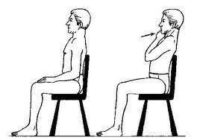

The muscles involved in swallowing can be strengthened using several exercise methods, such as the Shaker and tongue press exercises, chin tuck against resistance (CTAR) exercise, and submandibular push exercise 20, 21.

Conventional treatment methods such as oropharyngeal (including the muscles involved in swallowing) exercises, compensated maneuvers, and electrical stimulation of the oropharyngeal area are widely applied in swallowing therapy 11, 18, 19, 20, 21. Various methods have been employed to treat dysphagia. Moreover, the infra- and suprahyoid muscles support the opening of the upper esophageal sphincter (UES) by moving the hyoid bone anteriorly 8, 9, 10, 11, 12.ĭysphagia or difficulty swallowing may result from various problems such as neurological impairment and physiological and anatomical derangements in any region from the mouth to the esophagus (e.g., in the muscles involved in swallowing) 13, 14, 15, 16, 17. The role of the thyrohyoid muscle, one of the four infrahyoid muscles, is to move the larynx antero-superiorly during the swallowing process. The functions of the suprahyoid muscle in terms of the anterosuperior motions of the hyoid bone and the functions of the omohyoid, sternothyroid, and sternohyoid muscles and a part of the infrahyoid muscles in depressing the hyolaryngeal complex are understood 8, 9.

Of the muscles contributing to the swallowing process, the supra- and infrahyoid muscles have been extensively reported 2, 4, 5, 6, 7. The swallowing process is a compound sensori-motor behavior that includes the coordinated relaxation and contraction of the muscle tissues around the tongue, mouth, pharynx, larynx, and upper esophagus 1, 2, 3. The CTAR and Shaker exercises are also effective in this regard. The submandibular push exercise may be effective as a swallowing muscle exercise owing to its superiority in inducing selective contractions of the supra- and infrahyoid muscles. In terms of both the maximum and mean RMS values of the suprahyoid muscle, the Shaker exercise and submandibular push exercise showed a larger RMS value than the CTAR exercise in patients with swallowing difficulty ( p < 0.05). In terms of both the maximum and mean RMS values of the suprahyoid muscle, the submandibular push exercise showed a larger RMS value than the CTAR and Shaker exercises in healthy subjects ( p < 0.05). Differences in the activity of swallowing muscles among the three different exercises were analyzed using one-way repeated measured analysis of variance. During the three different types of exercises, the root mean square (RMS) values of the sternocleidomastoid (SCM), suprahyoid (anterior belly of the digastric and mylohyoid muscles), and infrahyoid (sternothyroid and thyrohyoid muscles) muscles were analyzed using surface EMG. Twenty-five healthy subjects and 20 patients experiencing swallowing difficulty were enrolled. This study is a prospective non-randomized controlled study.

In this study, we compared the effectiveness of the CTAR, submandibular push, and Shaker exercises for the induction of selective supra- and infrahyoid muscle contractions using surface electromyography (EMG). Several exercise methods, such as the Shaker exercise, tongue press exercise, chin tuck against resistance (CTAR) exercise, and submandibular push exercise, have been introduced to strengthen the muscles involved in swallowing.


 0 kommentar(er)
0 kommentar(er)
